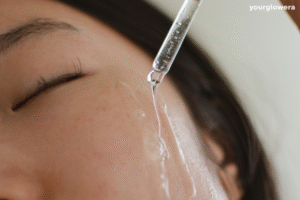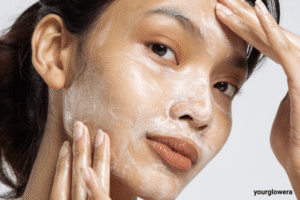Melasma is a frequent skin problem. It has dark discolored areas – they often appear on the face.
If you’re struggling with melasma, a well-curated skincare routine for melasma can help lighten these patches and even out your skin tone.
Comprehension of the reasons and discovery of the correct treatment is important to get a complexion that is radiant and even.
In this guide, we will dive deep into the best practices and skincare routine for melasma treatment, provide expert skincare tips, and highlight some budget-friendly product recommendations to create the perfect skincare routine for melasma.
Whether you’re new to melasma or have been managing it for years, this guide will equip you with the tools to tackle this condition with confidence.
Table of Contents
1. What is Melasma and What Causes It?
Before diving into a skincare routine for melasma, it’s important to understand what melasma is and what causes it.
Melasma is a hyperpigmentation disorder. It results in dark brown or greyish patches on the skin, which are characteristic of melasma.
It primarily affects women, especially those with darker skin types, and is often triggered by hormonal changes, pregnancy (commonly known as the “mask of pregnancy”), birth control pills, and excessive sun exposure.
UV radiation makes the skin produce melanin, the pigment that gives skin its color causing melasma to appear. Knowing these triggers can help you make smarter choices about your skincare routine for melasma.

2. The Significance of Incorporating Sunscreen into Your Skincare Routine for Managing Melasma
When it comes to managing melasma, sunscreen is the most important step in your skincare routine for melasma.
Sunlight makes the problem worse, so protection of your skin from harmful UV rays is important. Pick a broad-spectrum sunscreen with SPF 30 or higher to protect against both UVA and UVB rays.
Look for sunscreens that contain zinc oxide or titanium dioxide, as these ingredients are physical blockers that stay on the skin’s surface, providing extra protection.
3. Gentle Cleansing to Maintain Skin Balance
For any skincare routine for melasma, cleansing is an important step. Using a gentle cleanser helps remove dirt, oil, and impurities that could irritate the skin.
Don’t use harsh scrubs or foamy cleansers that can strip your skin’s natural oils.
Instead, choose a mild, hydrating cleanser with ingredients like glycerin or hyaluronic acid to keep the skin hydrated and balanced.
4. Exfoliating to Promote Skin Cell Turnover
Exfoliation has a crucial part in skincare routine for melasma to remove dead skin cells and speed up cell renewal.
This step can assist with a less visible appearance of dark areas over a period. But make sure to use mild exfoliants to keep away from irritating sensitive skin.
Exfoliating acids like glycolic acid and lactic acid are cost-effective and effective options for improving skin texture and tone.
These chemical exfoliants gently eliminate dead skin cells from the surface without the need for physical scrubbing.
Applying them 2-3 times a week can leave your skin feeling smooth, refreshed, and revitalized.
5. Brightening Ingredients for Melasma
When it comes to targeting melasma, incorporating ingredients that brighten the skin is essential. Some of the most effective ingredients for treating melasma include:
- Vitamin C: it is an antioxidant that brightens dark spots also improves the overall skin tone.
- Niacinamide: Popularly reputed for its skin-tone uniformizing properties and its ability to lighten the skin color.
- Licorice Extract: Helps stop melanin production making dark spots less noticeable.
Look for serums or creams that contain these ingredients to specifically target melasma.

6. Targeted Treatments for Melasma
In addition to general skincare products, there are specialized treatments that can help fade melasma more effectively. These include:
- Hydroquinone: A skin-lightening agent that inhibits melanin production, helping to lighten darkened areas of the skin.
- Retinoids: These vitamin A derivatives help accelerate skin turnover, which can lighten dark patches over time. However, they can be irritating, so use them with caution and only at night.
- Azelaic Acid: A mild yet powerful choice to cut down melanin creation and make skin brighter.
Always consult with a dermatologist before adding potent ingredients like hydroquinone or retinoids to your routine.
7. Moisturizing for Healthy, Hydrated Skin
Keeping the skin moisturized is crucial when managing and building skincare routine for melasma. Dry, irritated skin can exacerbate pigmentation problems.
Select a moisturizer appropriate for your skin type that offers adequate hydration while avoiding pore-clogging ingredients.
Look for a product that contains soothing ingredients such as aloe vera or ceramides to support your skin’s barrier function.
8. Incorporating Antioxidants for Skin Health
Antioxidants play an important role in protecting the skin from oxidative stress, which can worsen melasma.
Ingredients like green tea extract, vitamin E, and resveratrol help neutralize free radicals and protect the skin from further damage.
Including antioxidant-rich serums or creams in your routine can promote healthier skin and minimize melasma flare-ups.
9. How to Choose the Right Products for Melasma on a Budget
It’s not necessary to spend a fortune on high-end skincare products to manage melasma effectively.
Many budget-friendly products are just as effective as their more expensive counterparts. Here are some affordable ingredients and products to consider adding to your skincare routine for melasma managing:
- Cleansers: Look for drugstore brands with hydrating formulas like CeraVe Hydrating Cleanser.
- Vitamin C Serums: Affordable options like La Roche-Posay Pure Vitamin C Face Serum or TruSkin Vitamin C Serum are effective choices for brightening and improving skin tone.
- Niacinamide Products: The Ordinary Niacinamide 10% + Zinc 1% is a budget-friendly choice that helps even out your skin tone.
10. When to Seek Professional Treatment for Melasma
While a proper skincare routine can help manage melasma, professional treatments may be necessary for more severe cases. If over-the-counter products aren’t working, a dermatologist may recommend treatments such as:
- Chemical Peels: These can help lighten dark patches by removing the top layer of skin.
- Laser Treatments: Laser therapies, like fractional lasers, can target hyperpigmented areas and improve overall skin tone.
- Micro-Needling: This treatment stimulates collagen growth and can enhance the appearance of melasma.
It’s important to discuss your treatment options with a professional to determine the best approach for your skin.

Conclusion: A Skincare Routine for Melasma Takes Patience and Consistency
When it comes to creating the best skincare routine for melasma, consistency is key.
Follow a routine that includes sun protection, gentle cleansing, exfoliation, brightening treatments, and moisturization. It may take some time, but with patience, you’ll achieve clearer, more even-toned skin.
Additionally, budget-friendly products can still offer excellent results, so you don’t need to break the bank to manage melasma effectively.
Remember, the goal is to find a routine that works best for your skin type and needs.
If you ever feel uncertain, seeking guidance from a dermatologist can provide personalized advice and treatments to support your skincare journey.
For a complete skincare routine to manage melasma, check out How to Make the Perfect Skincare Routine for Melasma: Step-by-Step Guide. This guide will walk you through each step for clearer, even-toned skin.
Frequently Asked Questions
What is the best skincare routine for melasma?
A good skincare routine for melasma involves gentle cleansing, applying a serum with ingredients like vitamin C or niacinamide, using a broad-spectrum sunscreen daily, and incorporating treatments like retinoids or chemical exfoliants under professional guidance.
Which serum is best for melasma?
Serums containing ingredients like Vitamin C, niacinamide, kojic acid, and licorice extract are beneficial for melasma. Look for products with brightening and skin-tone-evening properties.
What is the best skin procedure for melasma?
The most effective procedures for melasma include chemical peels, laser treatments like fractional CO2 or intense pulsed light (IPL), and micro needling.
What product is best for melasma?
Products with ingredients such as hydroquinone, niacinamide, vitamin C, and glycolic acid are ideal for treating melasma. Sunscreen is also a must.
Is vitamin C good for melasma?
Yes, vitamin C is a potent antioxidant that can brighten skin, reduce pigmentation, and protect against further damage caused by UV exposure.
What is the 3 cream for melasma?
A common combination for treating melasma includes hydroquinone, tretinoin (retinoid), and a corticosteroid. These are often used in a prescribed regimen by dermatologists.
What is the fastest way to cure melasma?
The fastest way to treat melasma includes a combination of sunscreen, topical treatments like hydroquinone, and professional treatments like chemical peels or lasers. However, results can take time and consistency.
Is niacinamide good for melasma?
Yes, niacinamide is excellent for melasma. It helps reduce pigmentation, improve skin texture, and enhance the overall appearance of the skin.
Is hyaluronic acid good for melasma?
While hyaluronic acid doesn’t directly treat melasma, it hydrates the skin, which is crucial in any skincare routine for maintaining a healthy complexion while treating pigmentation.
What is the first-line treatment for melasma?
Hydroquinone is often considered the first-line treatment for melasma, typically combined with other agents like tretinoin and corticosteroids.









Leave a reply